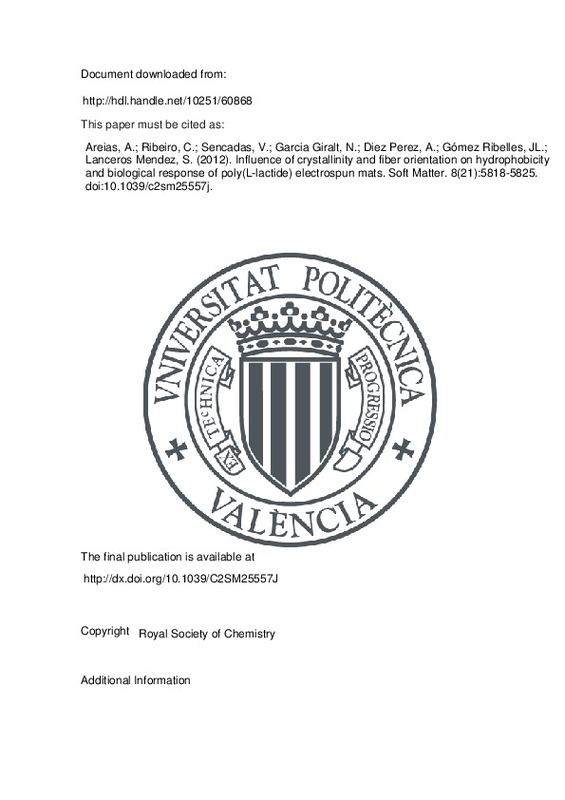JavaScript is disabled for your browser. Some features of this site may not work without it.
Buscar en RiuNet
Listar
Mi cuenta
Estadísticas
Ayuda RiuNet
Admin. UPV
Influence of crystallinity and fiber orientation on hydrophobicity and biological response of poly(L-lactide) electrospun mats
Mostrar el registro sencillo del ítem
Ficheros en el ítem
| dc.contributor.author | Areias, A.C.
|
es_ES |
| dc.contributor.author | Ribeiro, Clarisse
|
es_ES |
| dc.contributor.author | Sencadas, Victor
|
es_ES |
| dc.contributor.author | Garcia Giralt, Natalia
|
es_ES |
| dc.contributor.author | Diez Perez, A.
|
es_ES |
| dc.contributor.author | Gómez Ribelles, José Luís
|
es_ES |
| dc.contributor.author | Lanceros Mendez, Senen
|
es_ES |
| dc.date.accessioned | 2016-02-15T11:09:32Z | |
| dc.date.available | 2016-02-15T11:09:32Z | |
| dc.date.issued | 2012 | |
| dc.identifier.issn | 1744-683X | |
| dc.identifier.uri | http://hdl.handle.net/10251/60868 | |
| dc.description.abstract | [EN] Poly(L-lactide) electrospun mats have been produced with random and aligned fiber orientation and degrees of crystallinity from 0 up to nearly 50%. These two factors, fiber alignment and degree of crystallinity, strongly affect the hydrophobicity of the samples, this being larger for the aligned fiber mats and for the fibers with a higher degree of crystallinity. Whereas, the first effect can be associated with a decrease in the degree of porosity, the second should be related to an increase in fiber stiffness as the observed fiber roughness variations do not show strong differences between the samples. Proliferation of human chondrocytes cultured in a monolayer on these substrates is similar in both aligned and non-aligned amorphous mats. Crystallization of the aligned mats, on the other hand, nearly suppresses proliferation and the cells produce higher amounts of aggrecan, characteristic of the extracellular matrix of hyaline cartilage. | es_ES |
| dc.description.sponsorship | This work is funded by FEDER funds through the "Programa Operacional Factores de Competitividade - COMPETE'' and by national funds by FCT (Fundacao para a Ciencia e a Tecnologia, project references PTDC/CTM/69316/2006, PTDC/CTM-NAN/112574/2009, and NANO/NMed-SD/0156/2007). V.S. thanks the FCT for the SFRH/BPD/63148/2009 grant. C. R. thanks the IINL for the financial support via a PhD grant. NG thanks Red Tematica de Investigacion Cooperativa en Envejecimiento y Fragilidad (RETICEF), which is an initiative of the ISCIII and the Catalan Government (2009SGR00848). JLGR acknowledges the support of the Spanish Ministry of Education through project No. MAT2010-21611-C03-01 (including the FEDER financial support). The authors thank the support from the COST Action MP1003, 2010, 'European Scientific Network for Artificial Muscles' (ESNAM). | |
| dc.language | Inglés | es_ES |
| dc.publisher | Royal Society of Chemistry | es_ES |
| dc.relation.ispartof | Soft Matter | es_ES |
| dc.rights | Reserva de todos los derechos | es_ES |
| dc.subject | Mesenchymal Stem-Cells | es_ES |
| dc.subject | Nano-Structured Surfaces | es_ES |
| dc.subject | Osteoblast-Like Cells | es_ES |
| dc.subject | L-Lactic Acid | es_ES |
| dc.subject | In-Vitro | es_ES |
| dc.subject | Osteogenic Differentiation | es_ES |
| dc.subject | Superhydrophobic Surfaces | es_ES |
| dc.subject | Articular Chondrocytes | es_ES |
| dc.subject | Nanometer-Scale | es_ES |
| dc.subject | Tissue | es_ES |
| dc.subject.classification | MAQUINAS Y MOTORES TERMICOS | es_ES |
| dc.title | Influence of crystallinity and fiber orientation on hydrophobicity and biological response of poly(L-lactide) electrospun mats | es_ES |
| dc.type | Artículo | es_ES |
| dc.identifier.doi | 10.1039/c2sm25557j | |
| dc.relation.projectID | info:eu-repo/grantAgreement/MICINN//MAT2010-21611-C03-01/ES/MATERIALES BIOESTABLES Y BIOREABSORBIBLES A LARGO PLAZO COMO SOPORTES MACROPOROSOS PARA LA REGENERACION DEL CARTILAGO ARTICULAR/ | es_ES |
| dc.relation.projectID | info:eu-repo/grantAgreement/FCT/5876-PPCDTI/69316/PT/Multiferroic, magnetoelectric and metallic micro and nanocomposites based on electroactive polymers for advanced applications/ | |
| dc.relation.projectID | info:eu-repo/grantAgreement/FCT/5876-PPCDTI/112574/PT/PROTSENSOR - A novel pressure sensor network system for static and dynamic measurement. Application to the limb/prosthesis pressure mapping./ | |
| dc.relation.projectID | info:eu-repo/grantAgreement/COST//MP1003/EU/European Scientific Network for Artificial Muscles (ESNAM)/ | es_ES |
| dc.relation.projectID | info:eu-repo/grantAgreement/FCT/5876-PPCDTI/109368/PT/“Smart joint implants using bionanocomposites-(SIMBIO)”/ | |
| dc.relation.projectID | info:eu-repo/grantAgreement/FCT/SFRH/SFRH%2FBPD%2F63148%2F2009/PT/ELECTROACTIVE MATERIALS BASED POROUS MEMBRANES AND SCAFFOLDS FOR BIOMEDICAL APPLICATIONS/ | |
| dc.rights.accessRights | Abierto | es_ES |
| dc.contributor.affiliation | Universitat Politècnica de València. Departamento de Termodinámica Aplicada - Departament de Termodinàmica Aplicada | es_ES |
| dc.contributor.affiliation | Universitat Politècnica de València. Centro de Biomateriales e Ingeniería Tisular - Centre de Biomaterials i Enginyeria Tissular | es_ES |
| dc.description.bibliographicCitation | Areias, A.; Ribeiro, C.; Sencadas, V.; Garcia Giralt, N.; Diez Perez, A.; Gómez Ribelles, JL.; Lanceros Mendez, S. (2012). Influence of crystallinity and fiber orientation on hydrophobicity and biological response of poly(L-lactide) electrospun mats. Soft Matter. 8(21):5818-5825. https://doi.org/10.1039/c2sm25557j | es_ES |
| dc.description.accrualMethod | S | es_ES |
| dc.relation.publisherversion | http://dx.doi.org/10.1039/C2SM25557J | es_ES |
| dc.description.upvformatpinicio | 5818 | es_ES |
| dc.description.upvformatpfin | 5825 | es_ES |
| dc.type.version | info:eu-repo/semantics/publishedVersion | es_ES |
| dc.description.volume | 8 | es_ES |
| dc.description.issue | 21 | es_ES |
| dc.relation.senia | 234718 | es_ES |
| dc.contributor.funder | Fundação para a Ciência e a Tecnologia, Portugal | |
| dc.contributor.funder | European Cooperation in Science and Technology | es_ES |
| dc.contributor.funder | European Commission | |
| dc.contributor.funder | Ministerio de Ciencia e Innovación | es_ES |







![[Cerrado]](/themes/UPV/images/candado.png)

